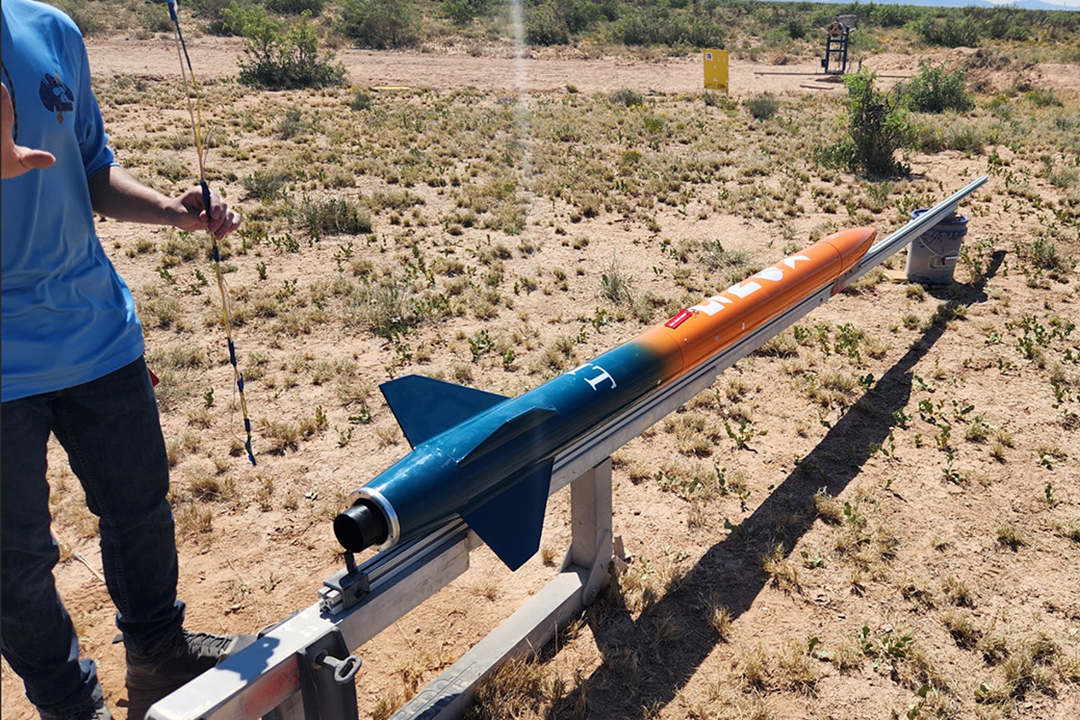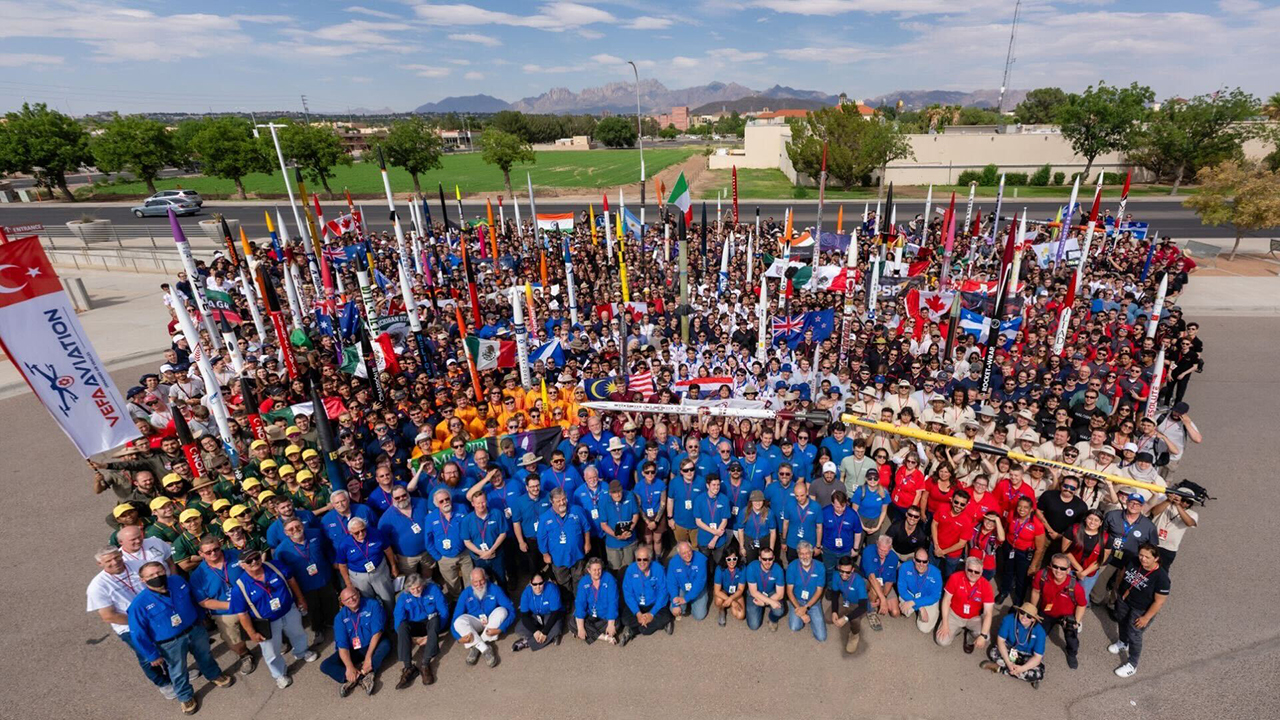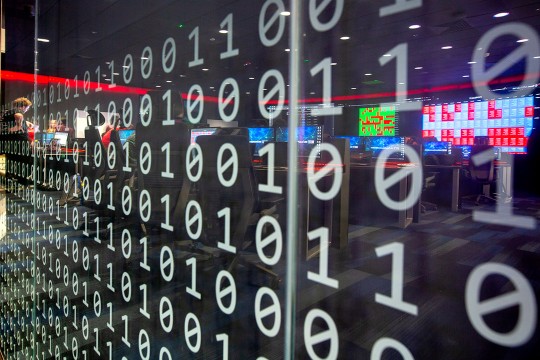RIT Launch Initiative team soars to first competition win in Spaceport America Cup 2023
Students take first place for the Payload Challenge at annual international event
Provided
RIT’s Launch Initiative student team won its first top award, the Space Dynamics Payload Challenge, at the annual Spaceport America 2023 event in Las Cruces, N.M. in July.
Members of the RIT Launch Initiative watched nervously as their 10-foot-tall rocket soared into the sky at the recent Spaceport America Cup event.
“It was the longest 20 minutes of my life,” said team member said Alex Speyer, a fifth-year mechanical engineering major in RIT’s Kate Gleason College of Engineering.
Moments later, with the payload ejecting successfully, all systems functioning, and the rocket reaching the required altitude of 10,000 feet, Speyer and the team cheered for their rocket named Kong—King of the Skies and the team’s first big national design competition win.
RIT’s Launch Initiative won first place in the Space Dynamics Laboratory Payload Challenge, part of the Intercollegiate Rocket and Engineering Competition (IREC) this summer in Las Cruces, N.M. They were among nearly 6,000 students from 159 international collegiate teams at the annual event that challenges students to launch solid, liquid, or hybrid rockets to altitudes of 10,000 and 30,000 feet.
Even the payload had a name—Anne, after the girl befriended by King Kong in the movie of the same name. Payloads are scientific experiments or contain sensor equipment needed for specific space missions. Anne was fitted with a new airbrake design the team developed to make airbrakes easier to implement into rockets to accurately achieve a desired maximum altitude. The objective was to test the new air brake design and collect data on how effective the brakes would be in slowing the payload on descent once ejected from 10,000-ft.—and ensuring equipment would not be damaged by 9Gs of force, twice the impact, on average, that individuals on roller coasters can experience.
Provided/RIT
Students built many of the rocket systems and equipment for Kong—King of the Skies, a 15-foot rocket.
“This is a very useful test because it allows us to verify our design under real flight conditions, such as 9G's, before implementing airbrakes into a rocket in the future, which we plan on doing very soon,” said Grace Dertinger, a fifth-year mechanical engineering major from Rochester, N.Y., and the team’s director of operations.
The payload data collecting system as well as a modular flight computer were original systems built by the students. They also built the rocket frame made of composite materials and 3D-printed several components.
“Our structures team was small, and we started work in the fall on wind tubes for the booster frame. We had some great success with new techniques,” said Speyer, who is from Strykersville, N.Y. New techniques included a 3D-printed mold for the nose cone which gave the rocket the sturdiness needed for flight even with a lighter-weight material. “It turned out fantastic.”
The modular flight computer propelled the rocket and received a “shout out” from event coordinators.
As part of the competition, teams submit technical reports about the rocket build process, and are judged by industry professionals. A handful are selected for presentations in front of all participants. Yevgenyi Gorbachev, a fourth-year mechanical engineering major from Far Rockaway, N. Y., was selected to represent the club, and detailed how he and the avionics team developed a modular flight computer that used Ethernet to communicate at high speed, and a set of standards that allows the team to build easily swappable modules in the future.
“This win and competition success has been multiple years in the making and was built upon a solid foundation of talented team members and alumni,” said Mike Buffalin, club advisor and SHED Makerspace Director. “The win also highlights the commitment level and dedication that is required of high-powered rocketry and elevates the RIT team in the national and international collegiate standings. It is great to watch the team’s camaraderie while tackling the challenging technical aspects of rocketry and still having fun in the process.”
Spaceport America
RIT was among the 158 international collegiate teams competing in the Intercollegiate Rocket and Engineering Competition.
Participation on the team provides real-world engineering and non-technical experience for future careers.
“Launch Initiative has helped me, especially in the public speaking aspect,” said Wynter Petersen, club president, and a fourth-year physics major from Los Gatos, Calif. “It is useful when you are trying to explain science to the general public. At IREC you have to present the project, our ideas and thought processes—the things that might sound simple in our heads, actually putting it into words and explaining it to other people is a very critical skill." This summer, Petersen is using both his technical and presentation skills as an observatory interpreter at Sunriver Nature Center and Observatory in Oregon.
The RIT Launch Initiative team will take its place in the new SHED building this fall when it opens (The SHED is the Student Hall for Exploration and Development).
Learn more about the team.
Watch videos of the rocket launch and payload deployment from IREC.















